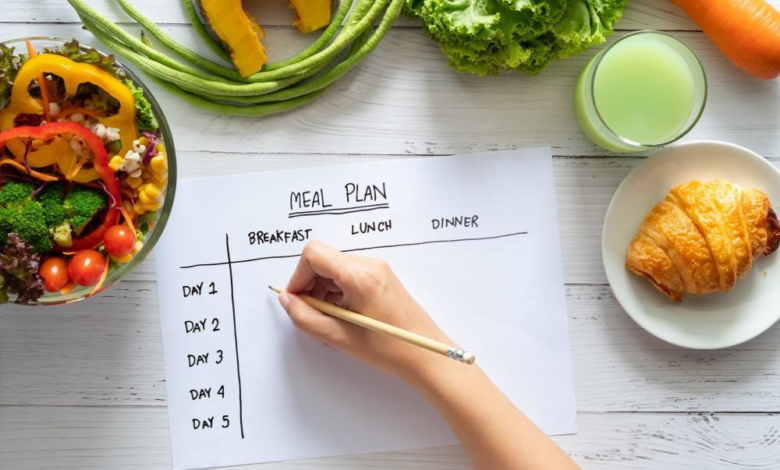Benefits of Meal Planning

Benefits of Meal Planning. Meal planning is a powerful tool that can transform your approach to eating, save you time and money, and improve your overall health. By taking a little time each week to plan your meals, you can make a big difference in your daily life. Let’s dive into the step-by-step guide to successful meal planning.
Benefits of Meal Planning
Health Benefits
Meal planning ensures you get improved nutrition by allowing you to thoughtfully select balanced meals that include all the necessary food groups. This approach can also aid in weight management by controlling portions and avoiding unhealthy impulse choices.
Time-Saving
One of the biggest advantages of meal planning is the time saved. By streamlining your grocery shopping and cooking processes, you can avoid last-minute trips to the store and the daily scramble to figure out what to eat.
Cost-Effective
Meal planning is also cost-effective. By planning your meals in advance, you can reduce food waste and create budget-friendly meals that maximize your grocery spending.
Reduced Stress
Having a meal plan reduces stress by eliminating the need to make daily decisions about what to eat. It encourages mindful eating and ensures you have everything you need for the week ahead.
Steps to Successful Meal Planning
Setting Goals
Start by setting clear goals for your meal planning. Consider your dietary goals, such as eating more vegetables, reducing sugar intake, or managing portion sizes. Also, factor in your budget considerations to ensure your meal plan is affordable.
Assessing Your Schedule
Look at your upcoming week and assess your schedule. Identify busy days when you might need quick meals and days when you have more time to cook. Plan to use leftovers for lunches or dinners to maximize efficiency.
Choosing Recipes
Select a variety of recipes to keep your meals balanced and interesting. Include a mix of simple and complex recipes to suit your time and energy levels throughout the week.
Creating a Meal Plan
Structure your week by creating a detailed meal plan. Include all meals and snacks, ensuring you have a balanced diet. Write down what you plan to eat for breakfast, lunch, dinner, and snacks each day.
Making a Grocery List
Create a grocery list organized by category (e.g., produce, dairy, meats) to make shopping easier. Check your pantry and fridge to see what you already have and avoid buying duplicates.
Shopping for Ingredients
Shop efficiently by sticking to your grocery list. Opt for seasonal and local produce when possible, as it’s often fresher and cheaper.
Meal Prep Techniques
Batch Cooking
Batch cooking involves preparing large quantities of food at once. This technique saves time and ensures you have meals ready to go. Cook big batches of soups, stews, or casseroles and freeze portions for later use.
Prepping Ingredients
Spend some time prepping ingredients, such as chopping vegetables or marinating proteins. This makes cooking during the week faster and more convenient.
Storing Meals
Use proper storage containers to keep your prepped meals fresh. Label and date your meals to easily keep track of what needs to be eaten first.
Tips for Staying Consistent
Sticking to Your Plan
While it’s important to stick to your meal plan, also allow for flexibility and adjustments. Life can be unpredictable, so be prepared to adapt your plan as needed.
Involving the Family
Get your family involved in meal planning and prep. This can make the process more enjoyable and ensures everyone is on board with the meal choices. Assigning tasks can also lighten the load.
Using Technology
Take advantage of meal planning apps and online resources. These tools can help you find recipes, create grocery lists, and stay organized.
Sample Meal Plans
Weekly Meal Plan for a Family
Breakfast:
- Monday: Oatmeal with fruit
- Tuesday: Scrambled eggs with toast
- Wednesday: Smoothie bowls
- Thursday: Yogurt with granola
- Friday: Pancakes
Lunch:
- Monday: Chicken salad
- Tuesday: Quinoa and veggie bowl
- Wednesday: Turkey wraps
- Thursday: Lentil soup
- Friday: Leftover pasta
Dinner:
- Monday: Baked salmon with vegetables
- Tuesday: Tacos
- Wednesday: Stir-fry with rice
- Thursday: Spaghetti with meatballs
- Friday: Homemade pizza
Snacks:
- Fruit slices
- Nuts and seeds
- Veggie sticks with hummus
Meal Plan for Weight Loss
Breakfast:
- Greek yogurt with berries
- Veggie omelet
- Smoothies
Lunch:
- Grilled chicken salad
- Tuna salad with avocado
- Veggie wrap
Dinner:
- Baked cod with quinoa
- Turkey chili
- Grilled vegetables with tofu
Snacks:
- Apple slices with peanut butter
- Carrot sticks
- Almonds
Vegetarian Meal Plan
Breakfast:
- Overnight oats
- Avocado toast
- Chia pudding
Lunch:
- Chickpea salad
- Veggie burrito bowl
- Hummus and veggie wrap
Dinner:
- Vegetable curry
- Stuffed bell peppers
- Lentil stew
Snacks:
- Mixed nuts
- Fruit salad
- Yogurt with honey
Common Mistakes to Avoid
Overcomplicating Recipes
Keep your meal plans simple to avoid feeling overwhelmed. Prioritize easy meals that don’t require a lot of time or complicated ingredients.
Not Being Flexible
Allow room for flexibility in your meal plan. Don’t stress if you need to switch meals around or make substitutions. Perfectionism can lead to frustration.
Ignoring Portion Sizes
Pay attention to portion sizes to avoid overeating. Use measuring cups or a food scale if necessary to ensure you’re eating the right amounts.
Conclusion
Meal planning is a game-changer for maintaining a healthy lifestyle. By setting goals, choosing balanced recipes, and prepping ahead, you can save time, money, and reduce stress. Start small, stay consistent, and enjoy the benefits of a well-planned diet. Benefits of Meal Planning.
FAQs
- How do I start meal planning if I’m a beginner?
- Begin with simple recipes and gradually incorporate more variety. Focus on planning a few days at a time before progressing to a full week.
- Can I meal plan on a tight budget?
- Absolutely! Meal planning can help you save money by reducing food waste and allowing you to buy in bulk.



